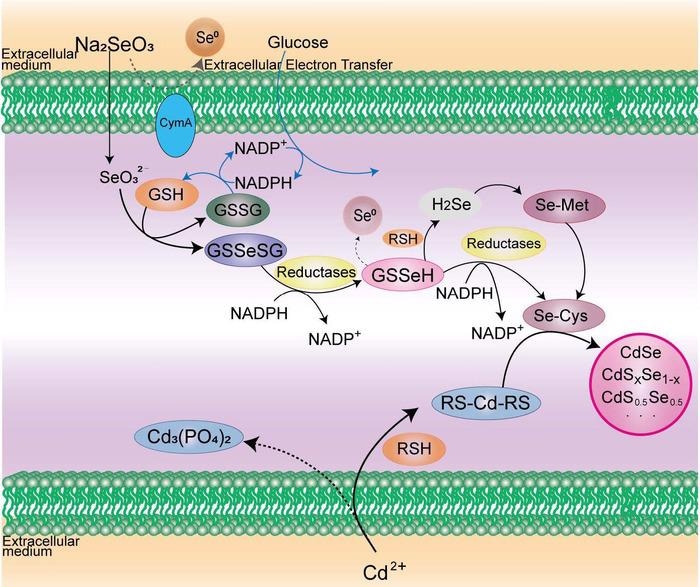Over the last decade, the cell has been leveraged as a strong tool to carry out sudden tasks with the help of artificial regulation.
 In the case of live-cell synthesis of CdSe QDs, it is essential to produce both reactive Se- and Cd-containing precursors at the proper intracellular location and timepoint by modulating intracellular reductive metabolism of sodium selenite and the detoxification of cadmium ion. Image Credit: ©Science China Press.
In the case of live-cell synthesis of CdSe QDs, it is essential to produce both reactive Se- and Cd-containing precursors at the proper intracellular location and timepoint by modulating intracellular reductive metabolism of sodium selenite and the detoxification of cadmium ion. Image Credit: ©Science China Press.
A cell has the ability to function as a potential chemical factory, provided the several reactive intermediates produced in the advanced metabolic processes and the subtle redox balance assisting the cellular homeostasis.
But even now, it is considered difficult to direct such reactions and pathways to synthesize preferred products as they naturally exist in various spatiotemporal dimensions inside the cell. Professor Dai-Wen Pang’s group suggested a concept of so-called “space-time coupled live-cell synthesis of nanocrystals.”
It specifically synthesizes nanocrystals by accurately and intentionally coupling a range of intracellular redox reactions and metabolic pathways, in a suitable spatial and temporal sequence in live cells.
Take yeast cells as an example, fluorescent semiconductor CdSe quantum dots (QDs) with tunable emission wavelengths could be synthesized by coupling the intracellular reductive metabolism of sodium selenite (Na2SeO3) with the activated detoxification of cadmium ion (Cd2+).
By correctly manipulating glutathione metabolic pathways, and the yield of QDs could be increased significantly, denoting the crucial role of glutathione throughout the generation of CdSe nanocrystals.
This appealing plan for the live-cell synthesis of nanocrystals has now been extended to mammalian cells and bacterial cells. Notably, cell-derived microvesicles can also be effectively labeled in situ along with intracellular-synthesized QDs.
As a result of their excellent fluorescent properties, intrinsic high extinction coefficient and biocompatibility, the intracellular-synthesized QDs and the QD-containing cells have been successful in converting into nanobioprobes for biodetection, having an electron and energy relay in an artificial photosynthesis system also being made.
With inspiration from the abovementioned mechanisms, the so-called cell-free quasi-biosynthesis systems that imitate the intracellular reactions have been designed to fabricate a range of nanocrystals under mild conditions, like alloy nanoparticles, noble-metal nanoparticles, fluorescent and functionalized QDs, and also other inorganic nanocrystals.
This versatile quasi-biosynthesis tends to be highly flexible and diversified, which has additionally reinforced the methodology for biosynthesis.
Live cell, known as a reservoir of biochemical reactions, has the potential to act as an amazing combined chemical plant where nanocrystal nucleation and growth, precursor formation and functional assembly can be executed precisely by artificial programming. But the current artificial-regulated synthesis simply utilizes the tip of an iceberg of metabolic pathways.
We hope to intrigue more researchers to explore new strategies and mechanisms to produce diverse multifunctional crystals and even intricate heteronanostructures. The concept we proposed will enable researchers to better exploit the unanticipated potentialities of live cells, open a new window for the field of synthetic biology, and shed light on the interdisciplinary studies of biology, chemistry and medicine.
Dai-Wen Pang, College of Chemistry, Nankai University
Journal Reference:
Liu, A.-A., et al. (2021) Artificial-regulated synthesis of nanocrystals in live cells. National Science Review. doi.org/10.1093/nsr/nwab162.